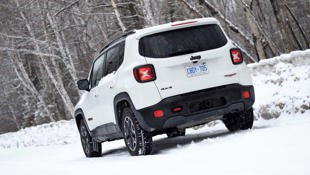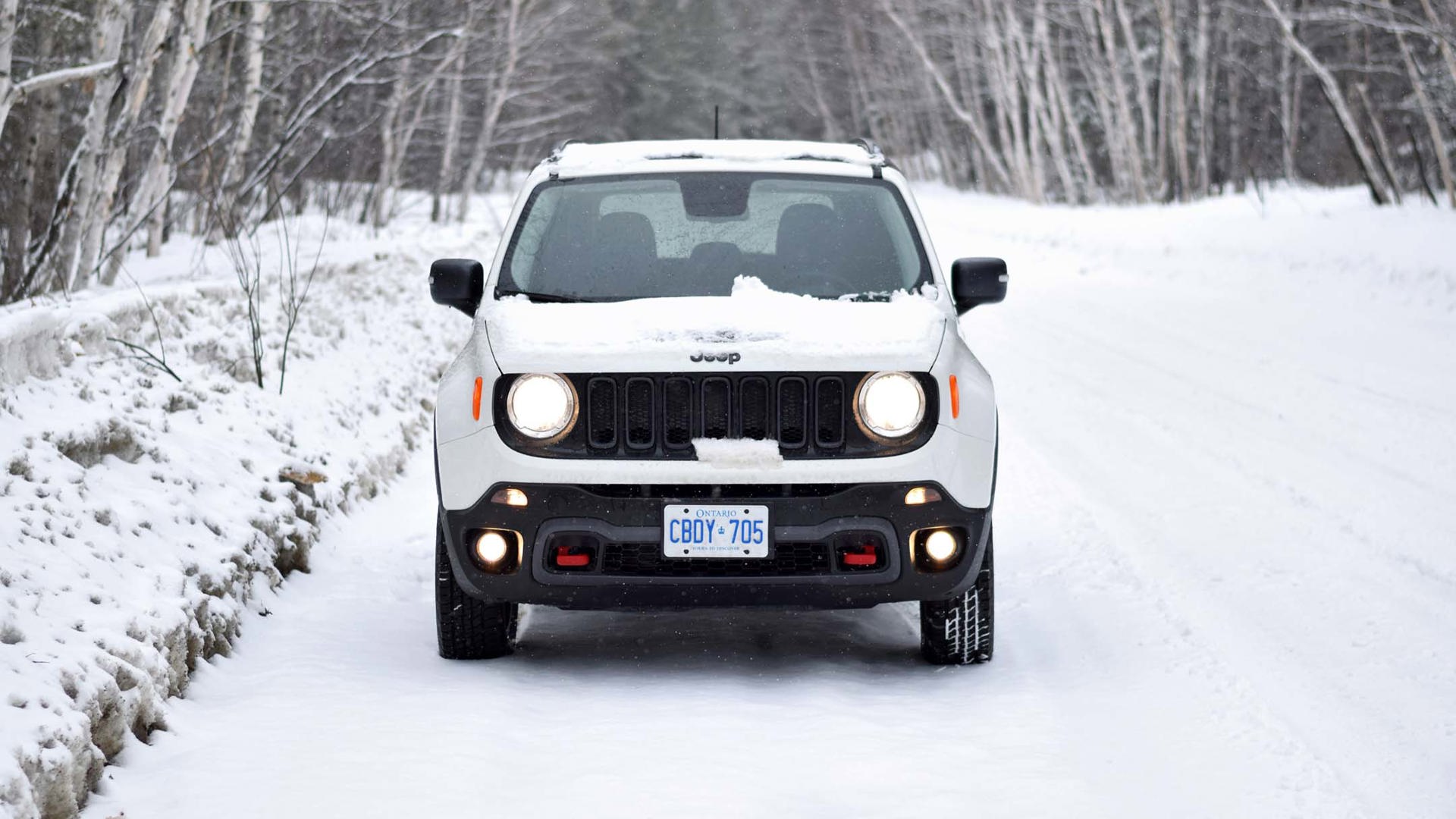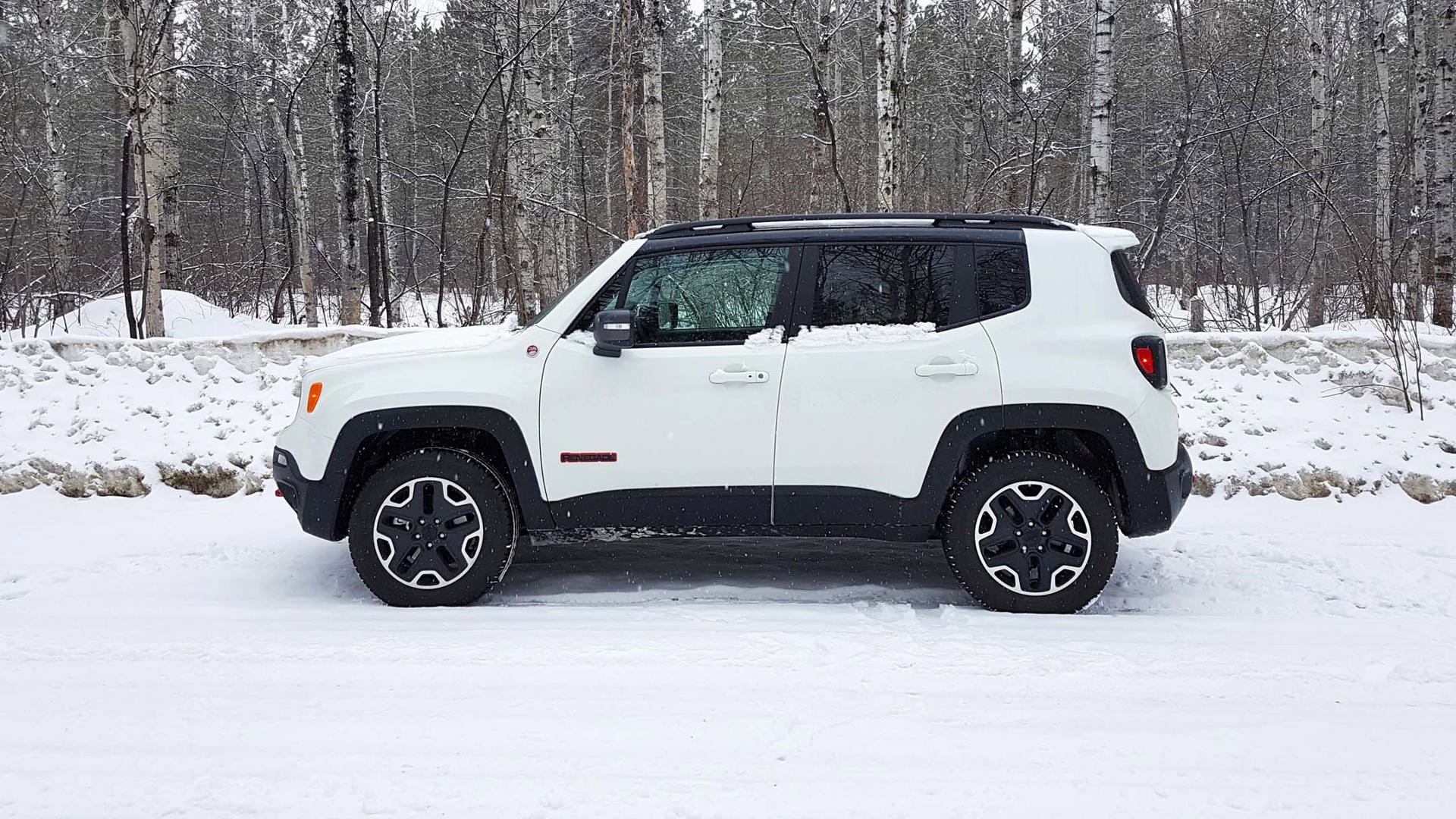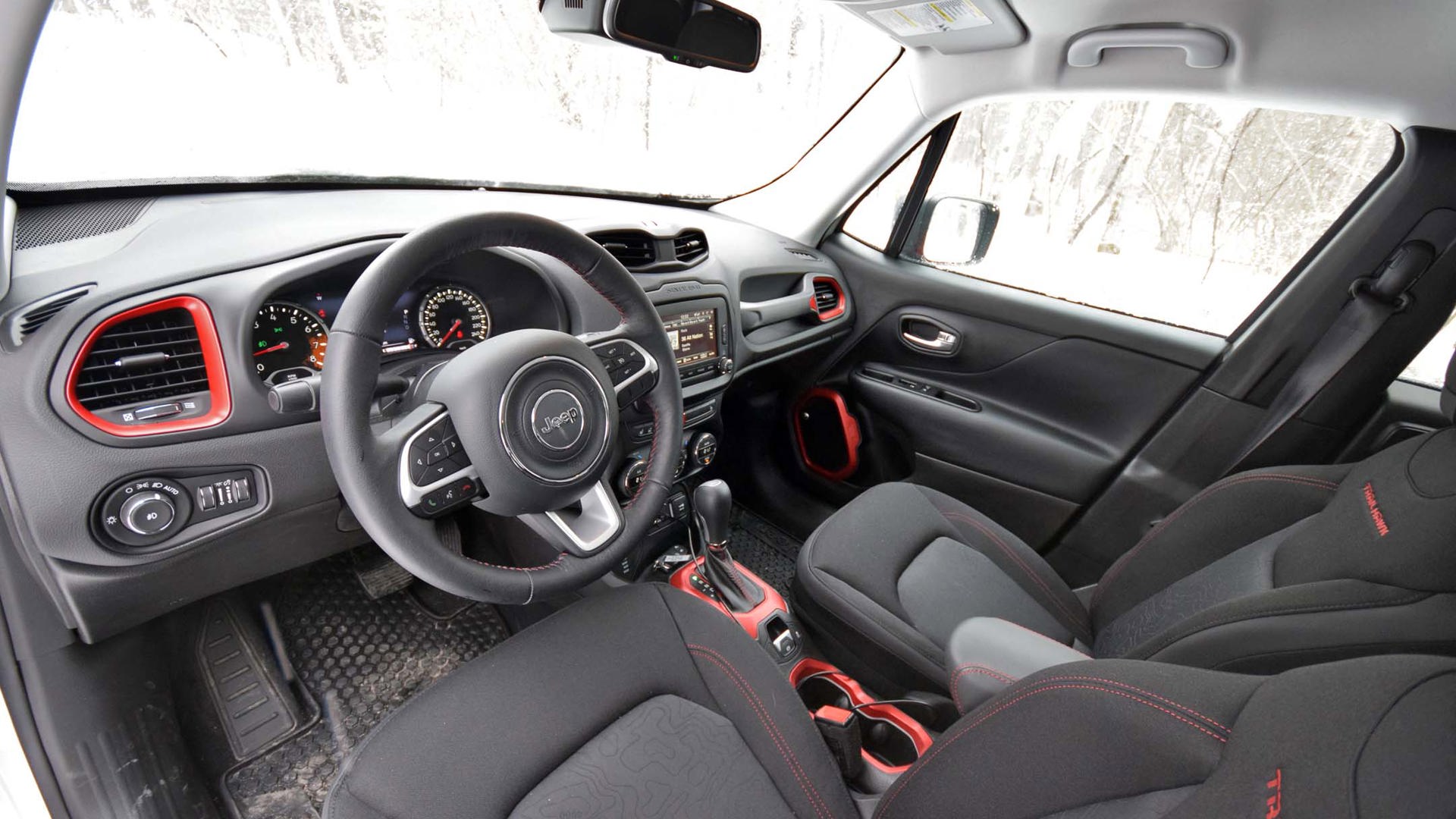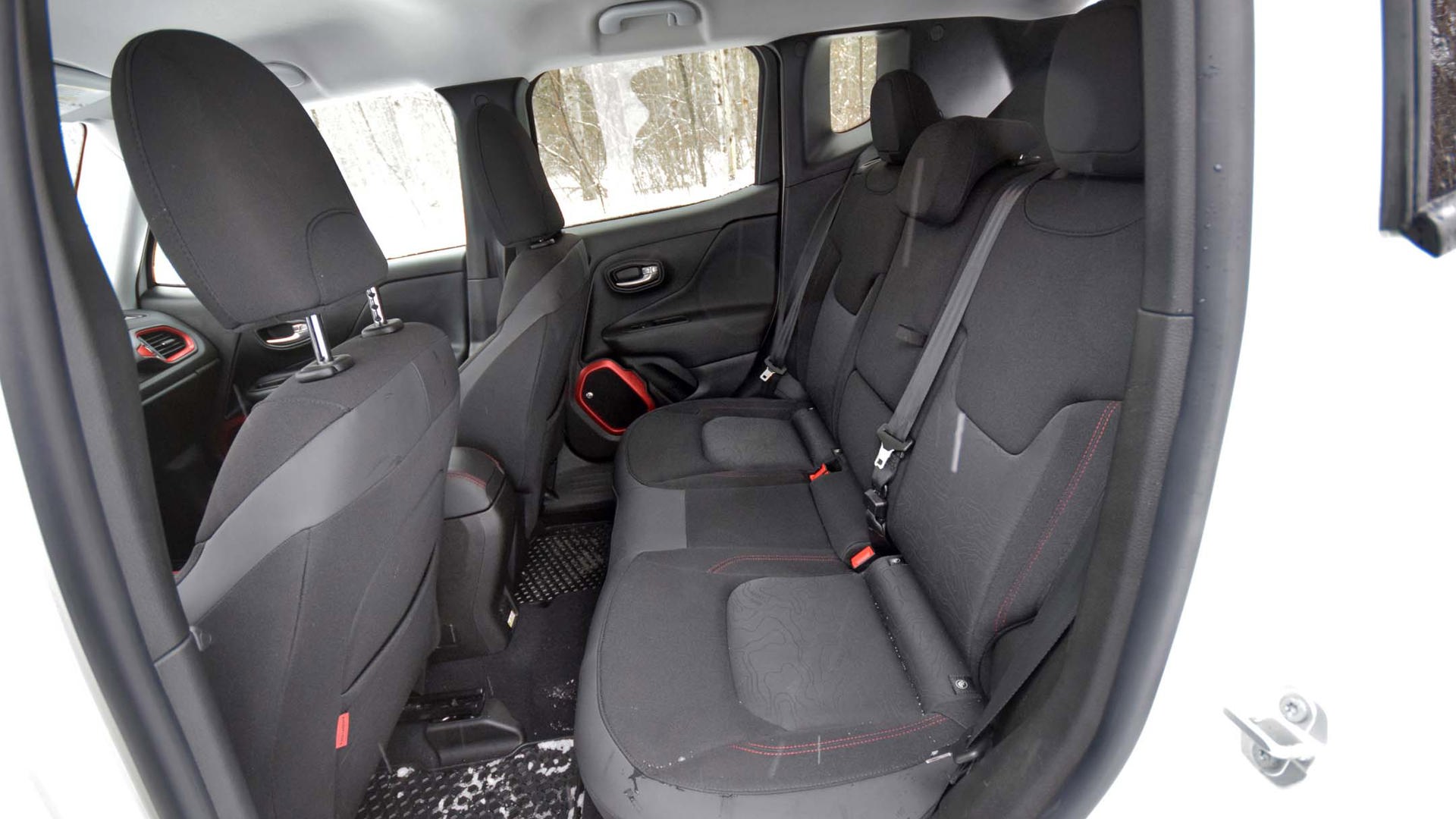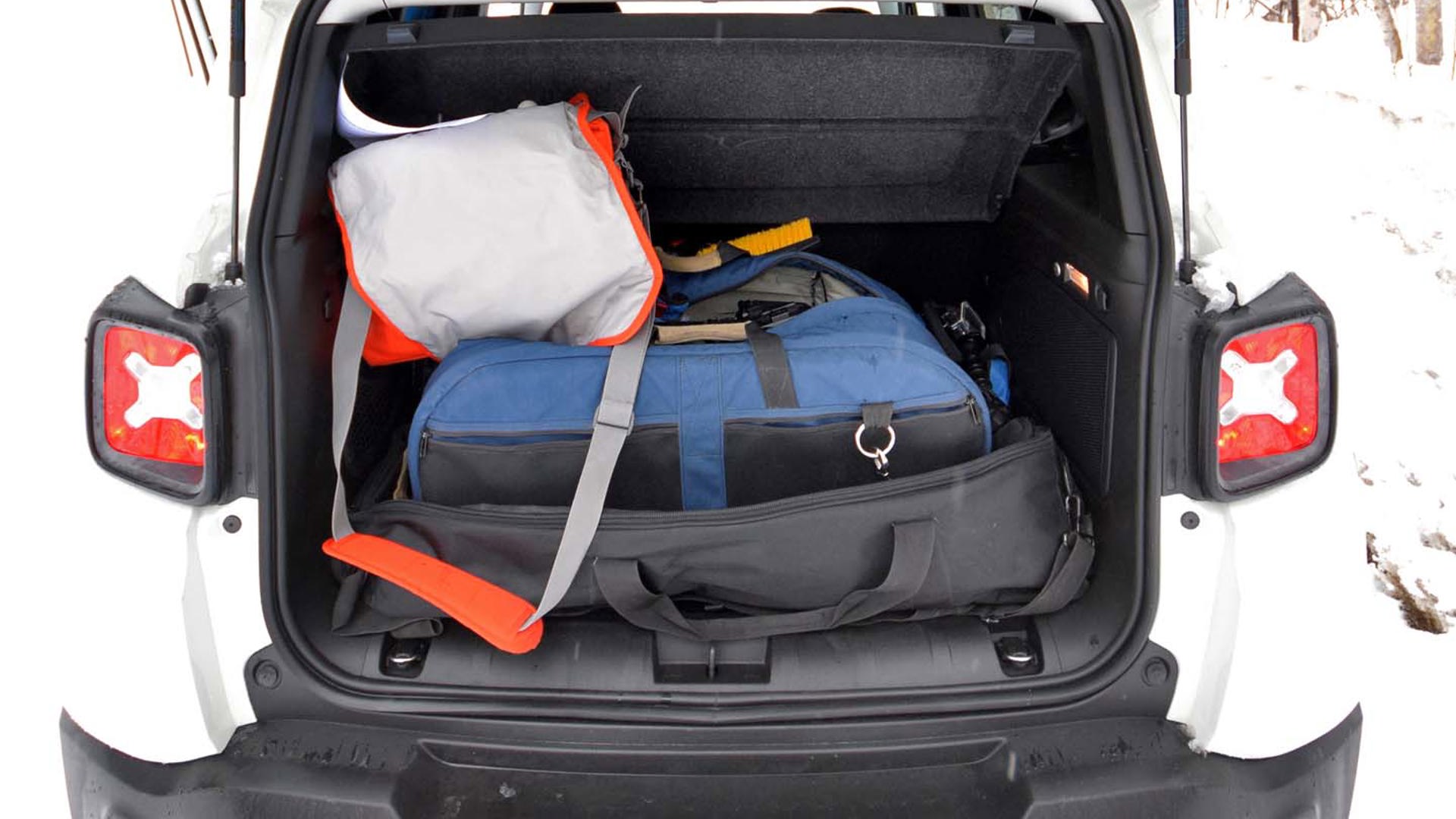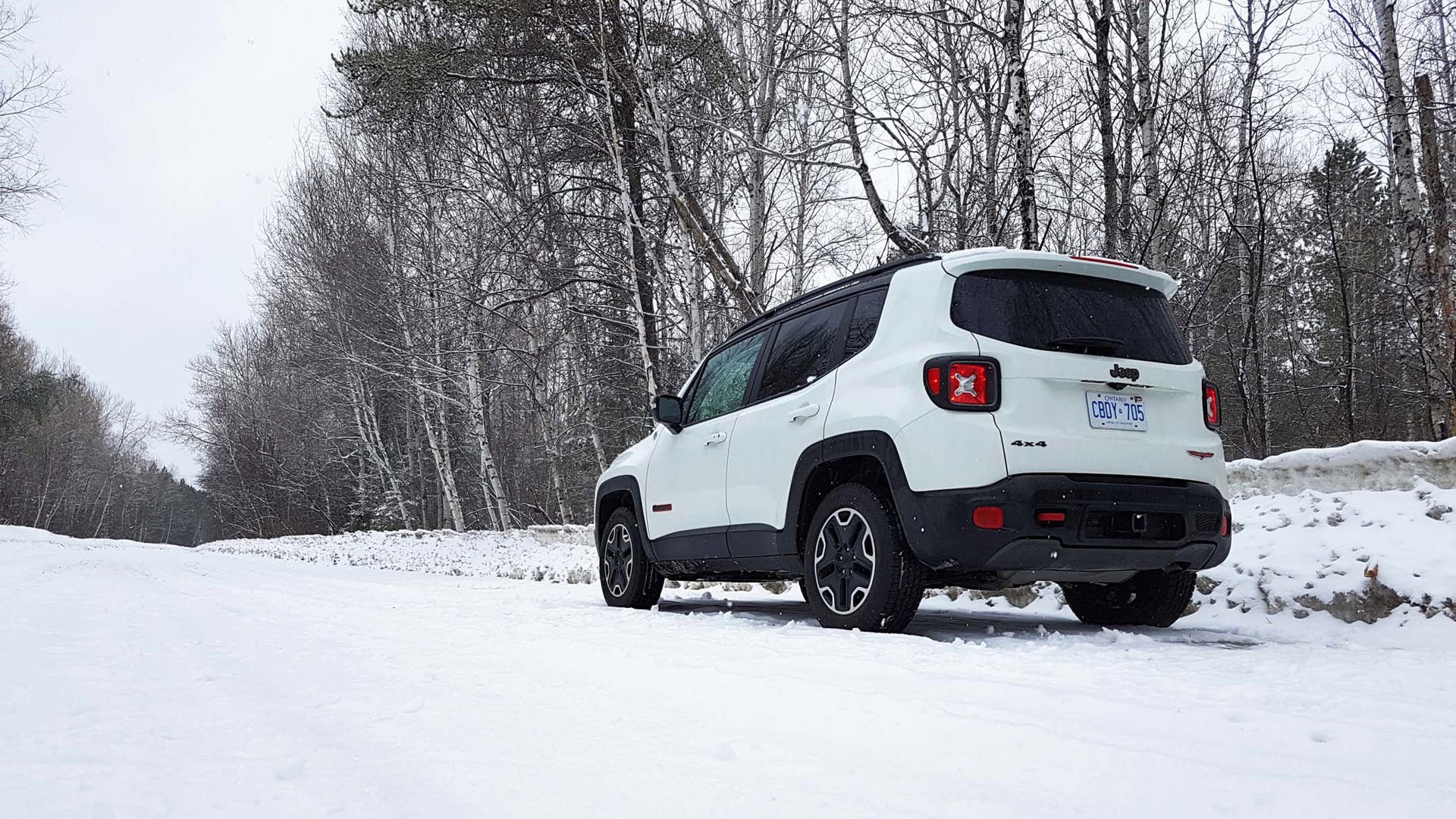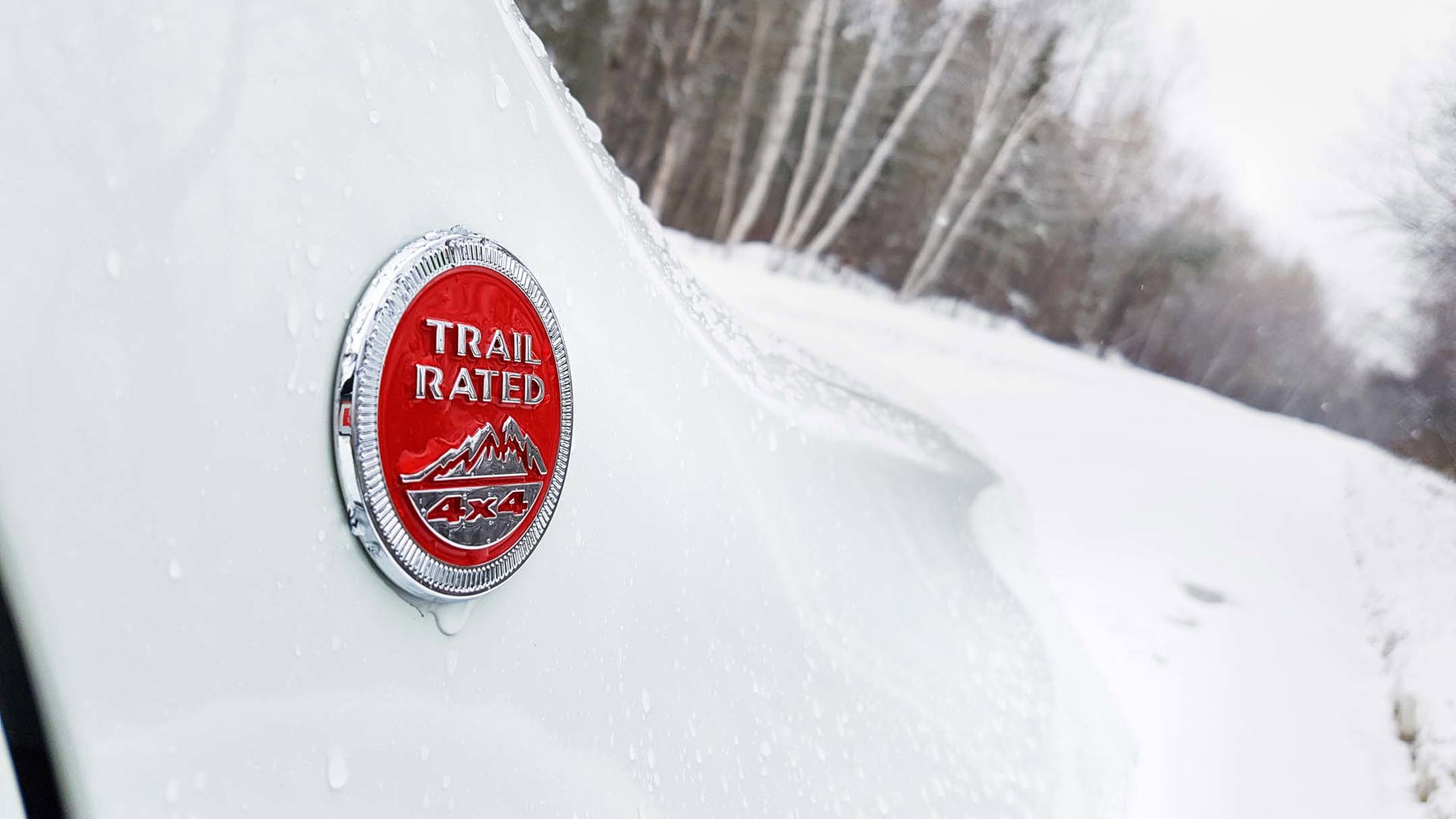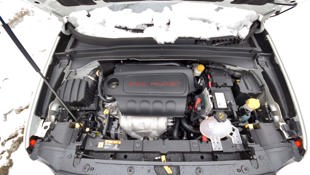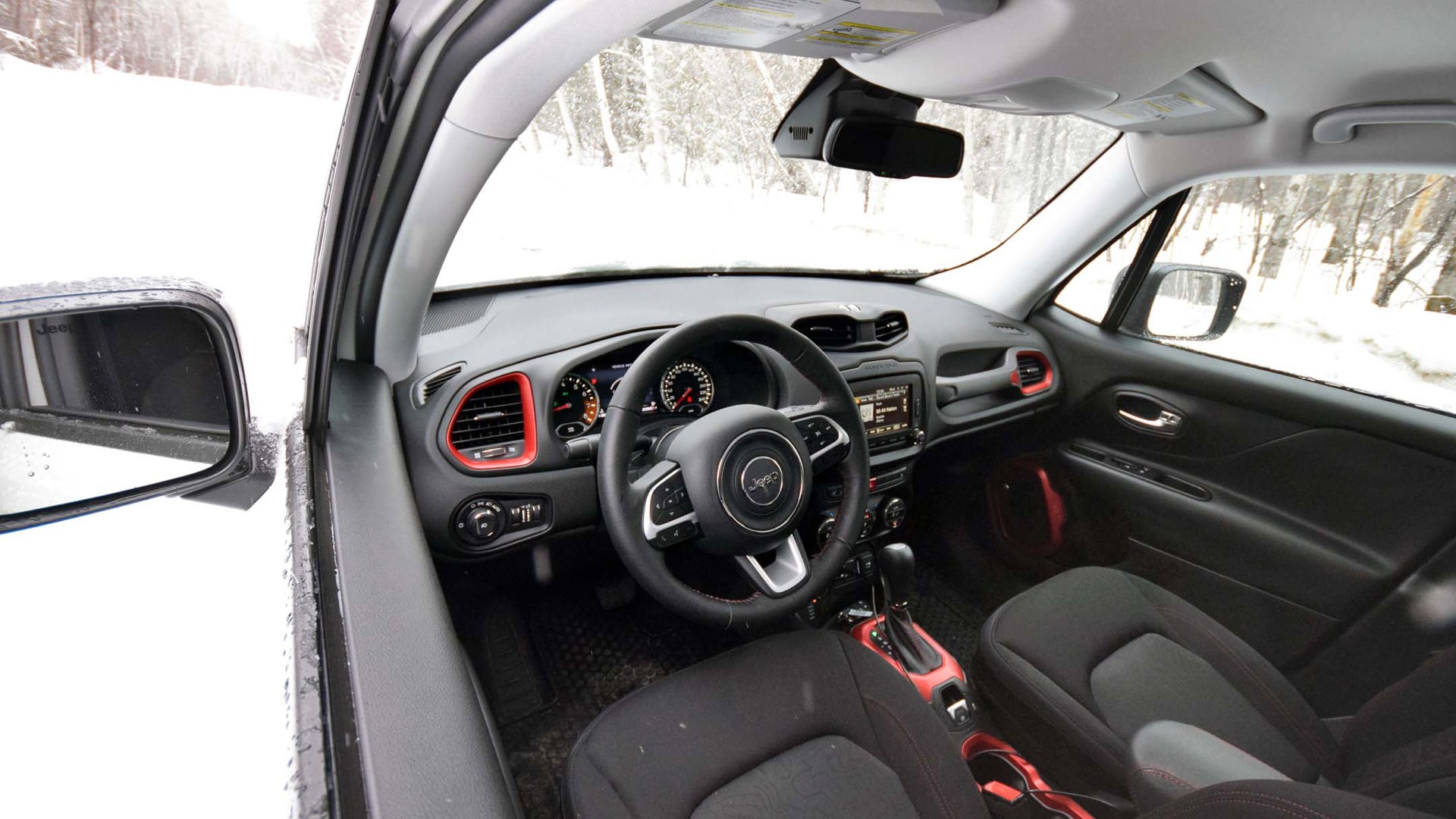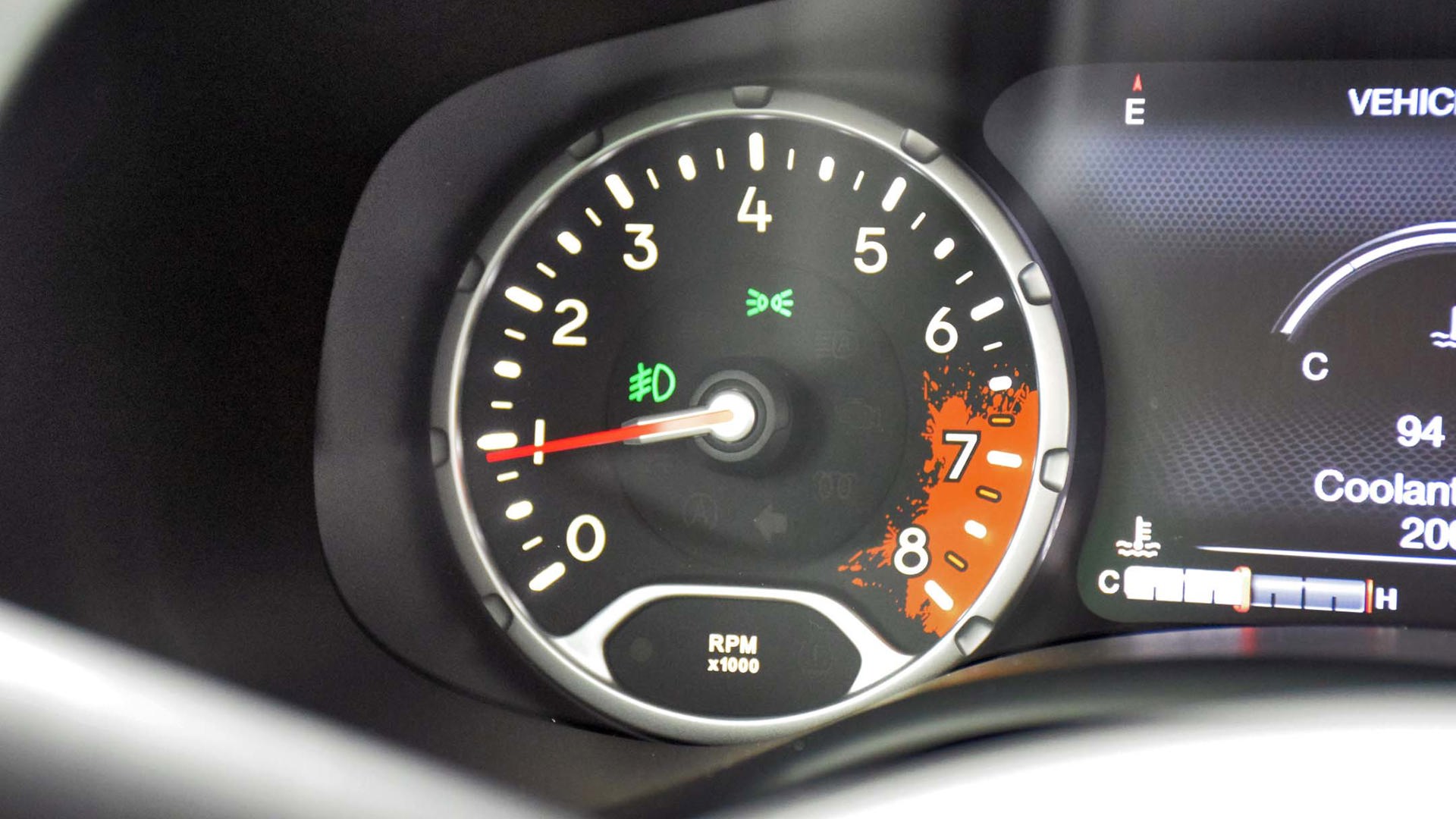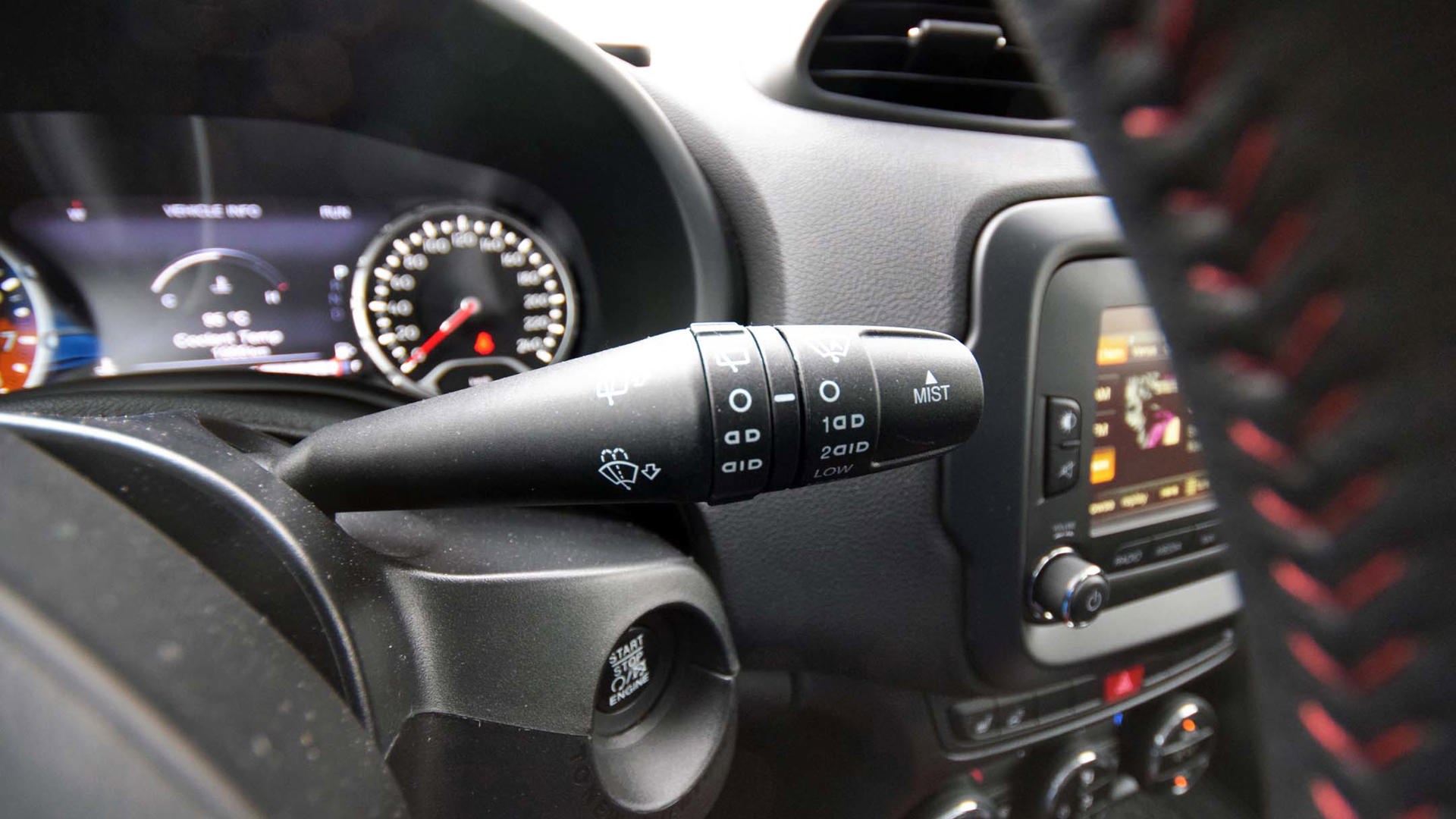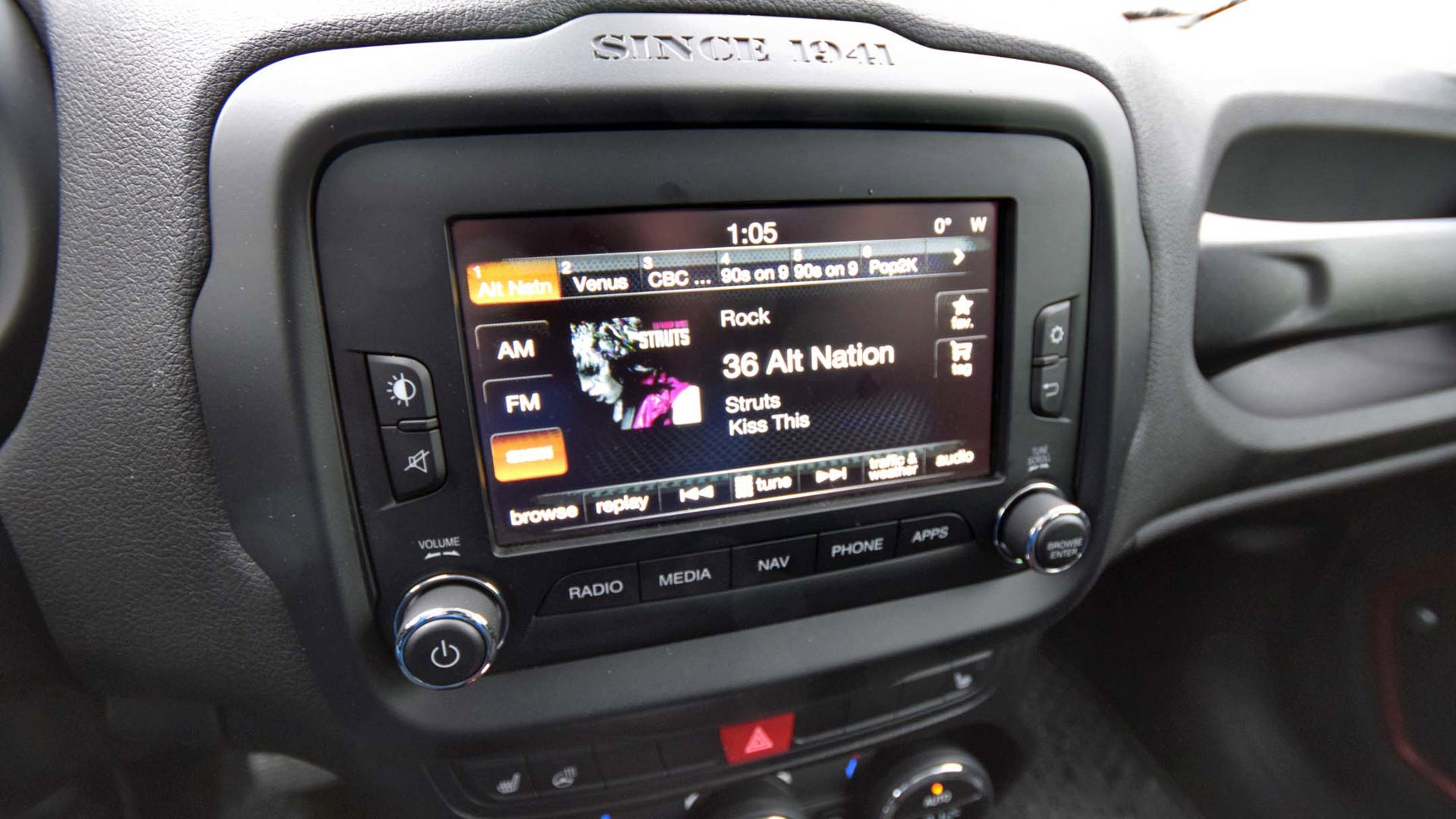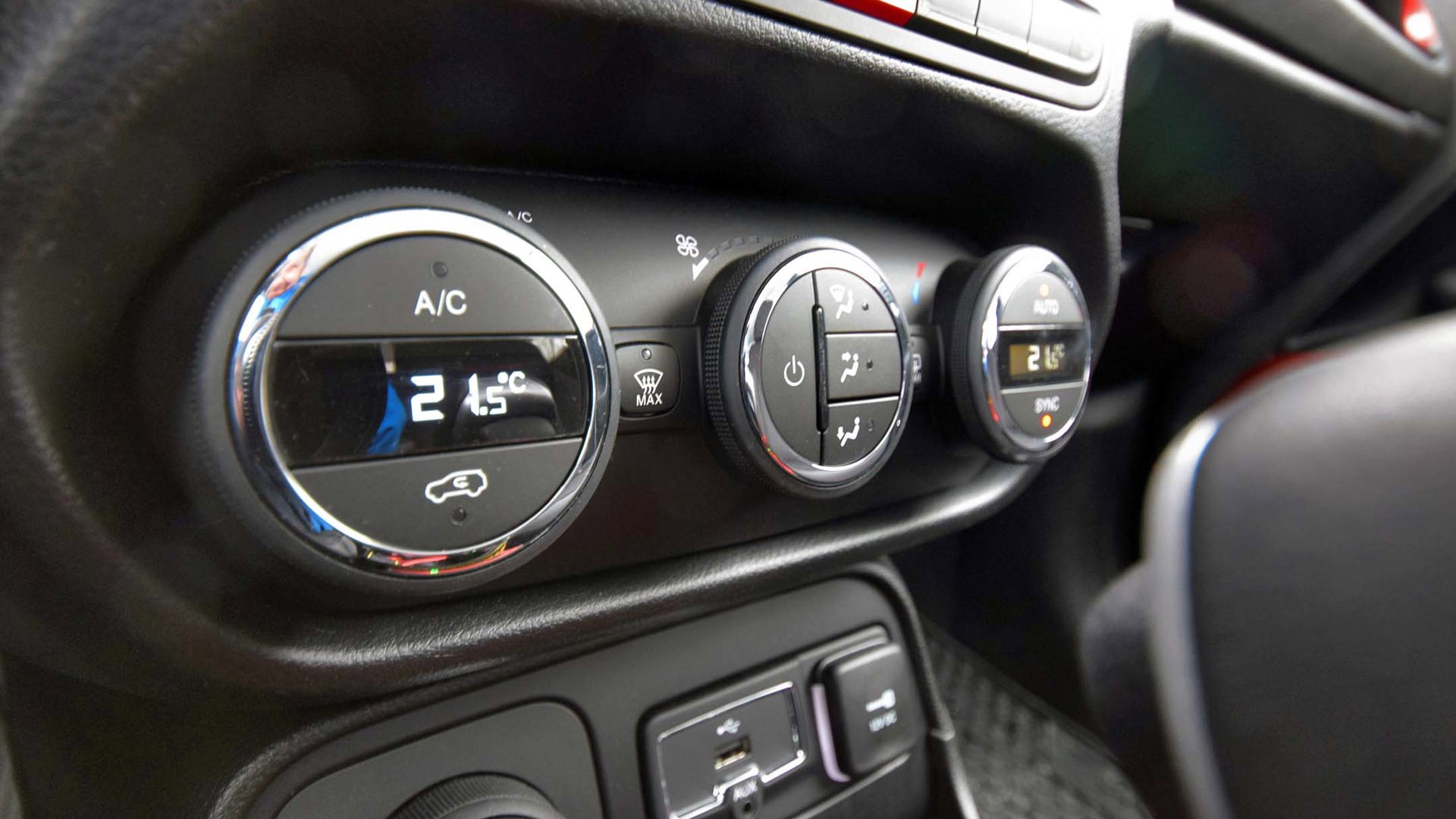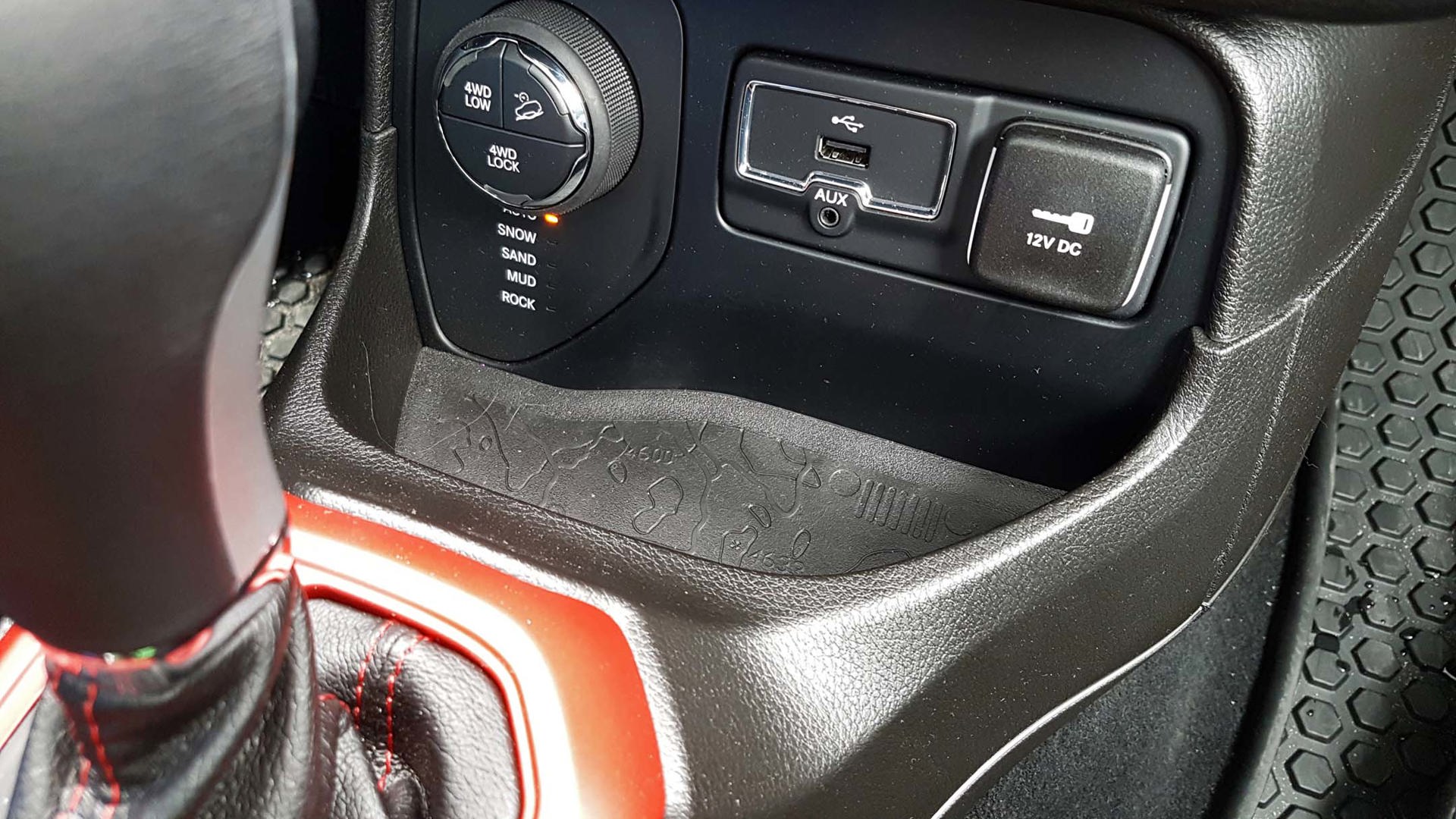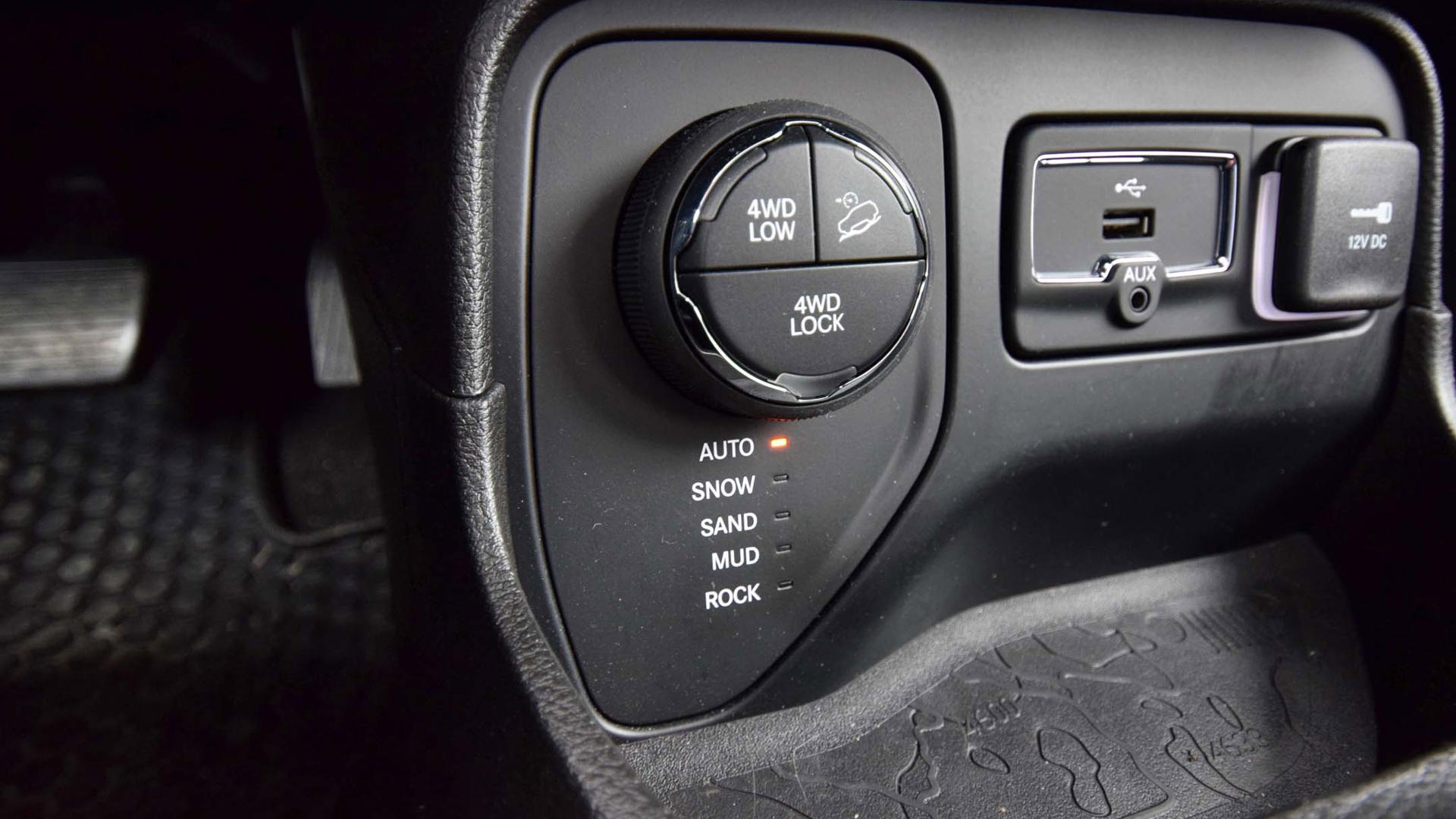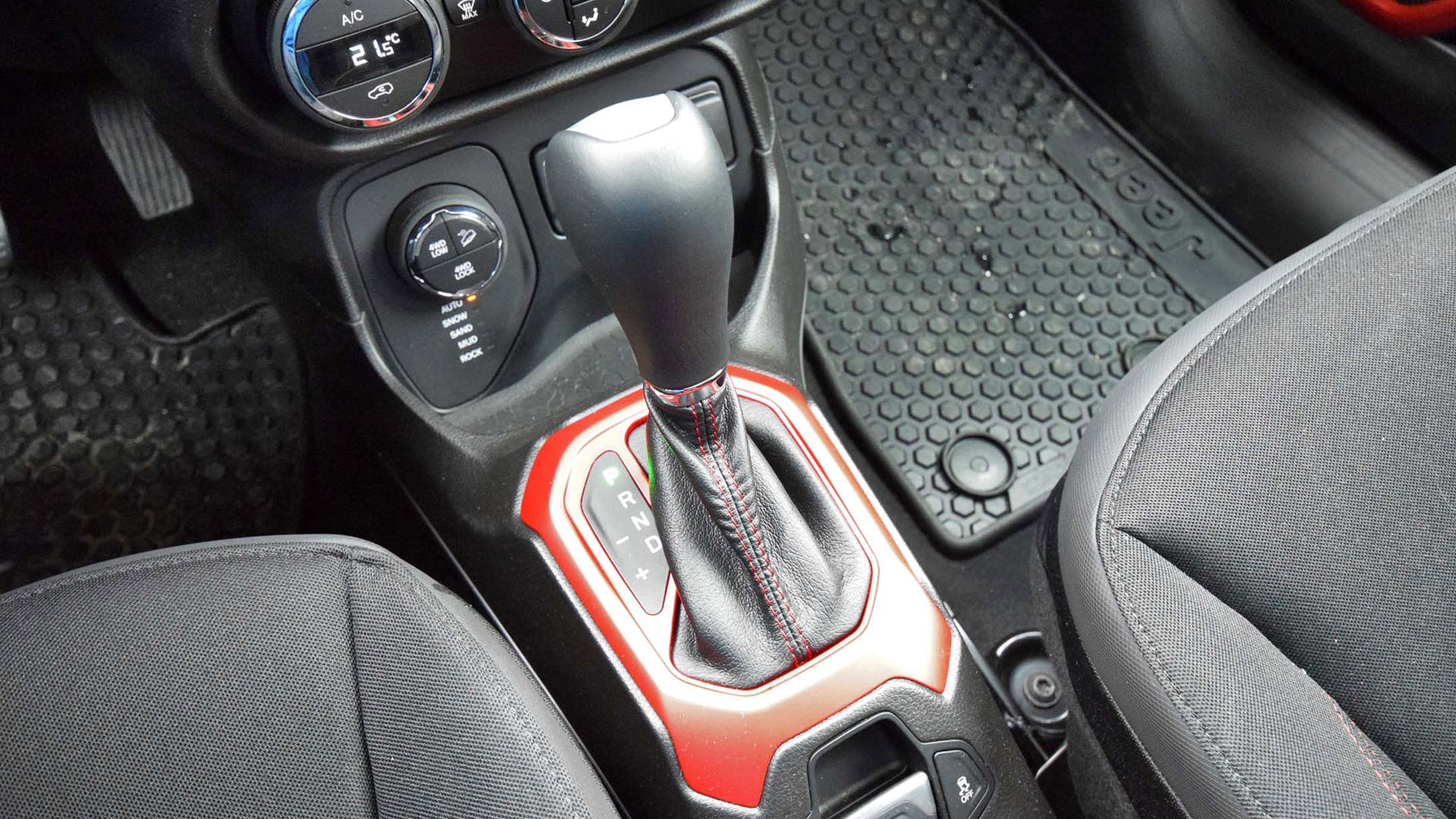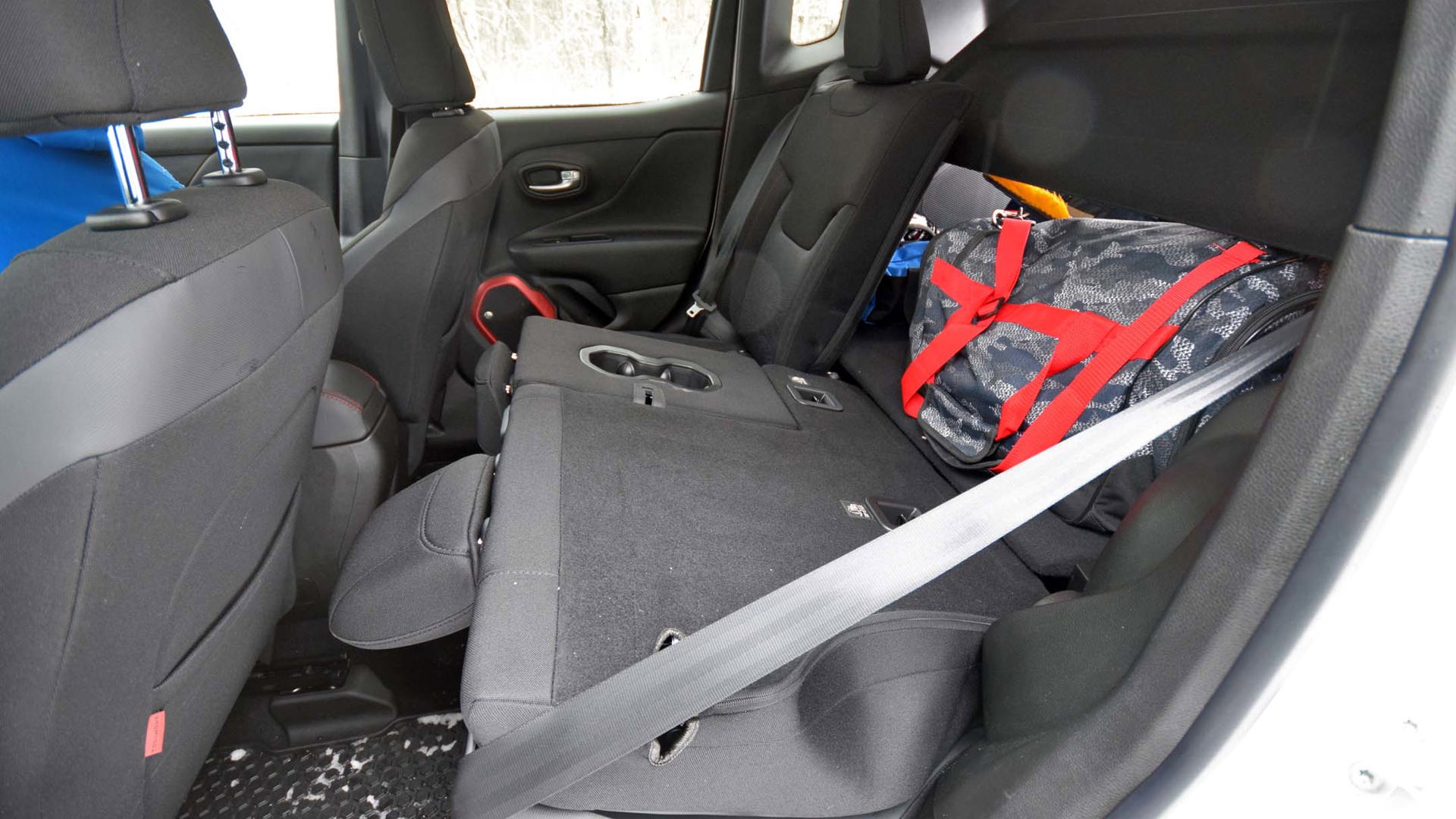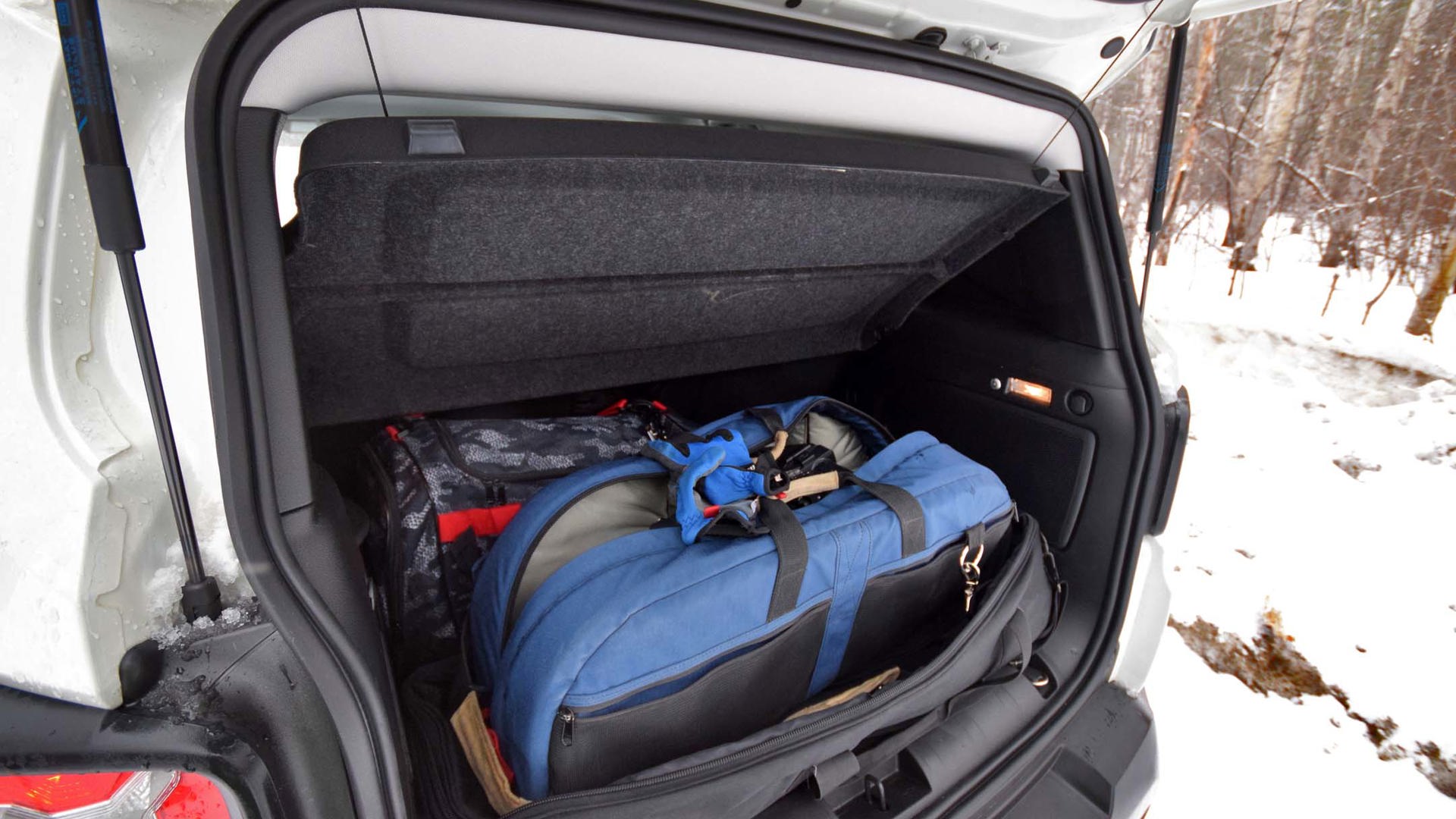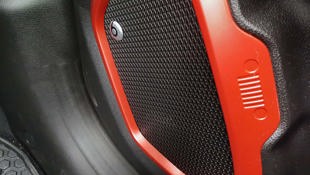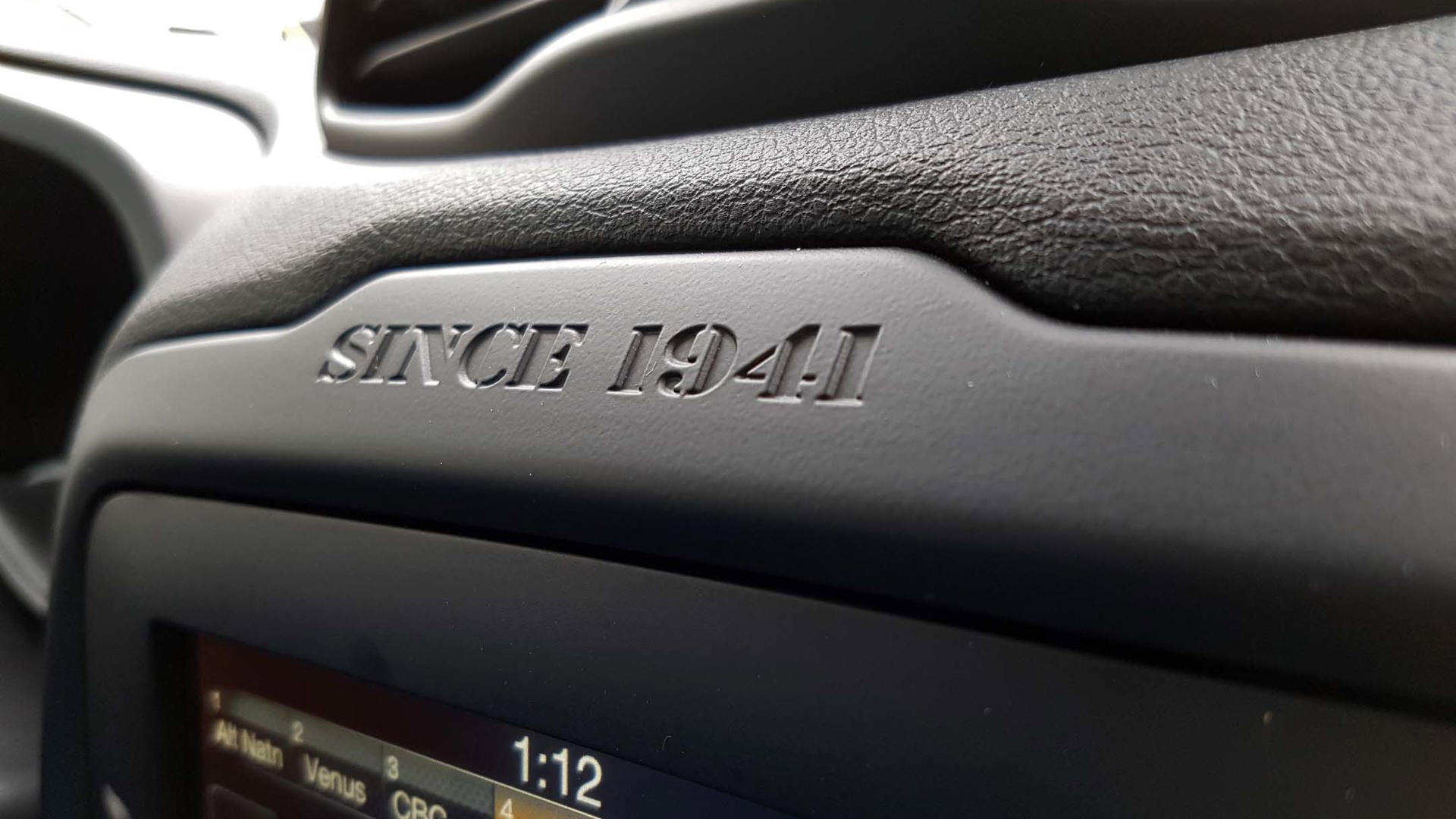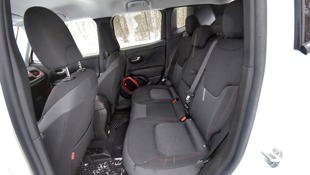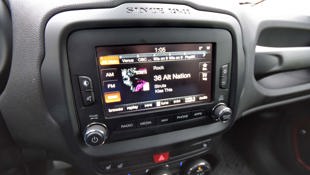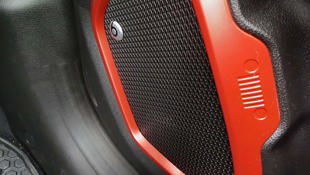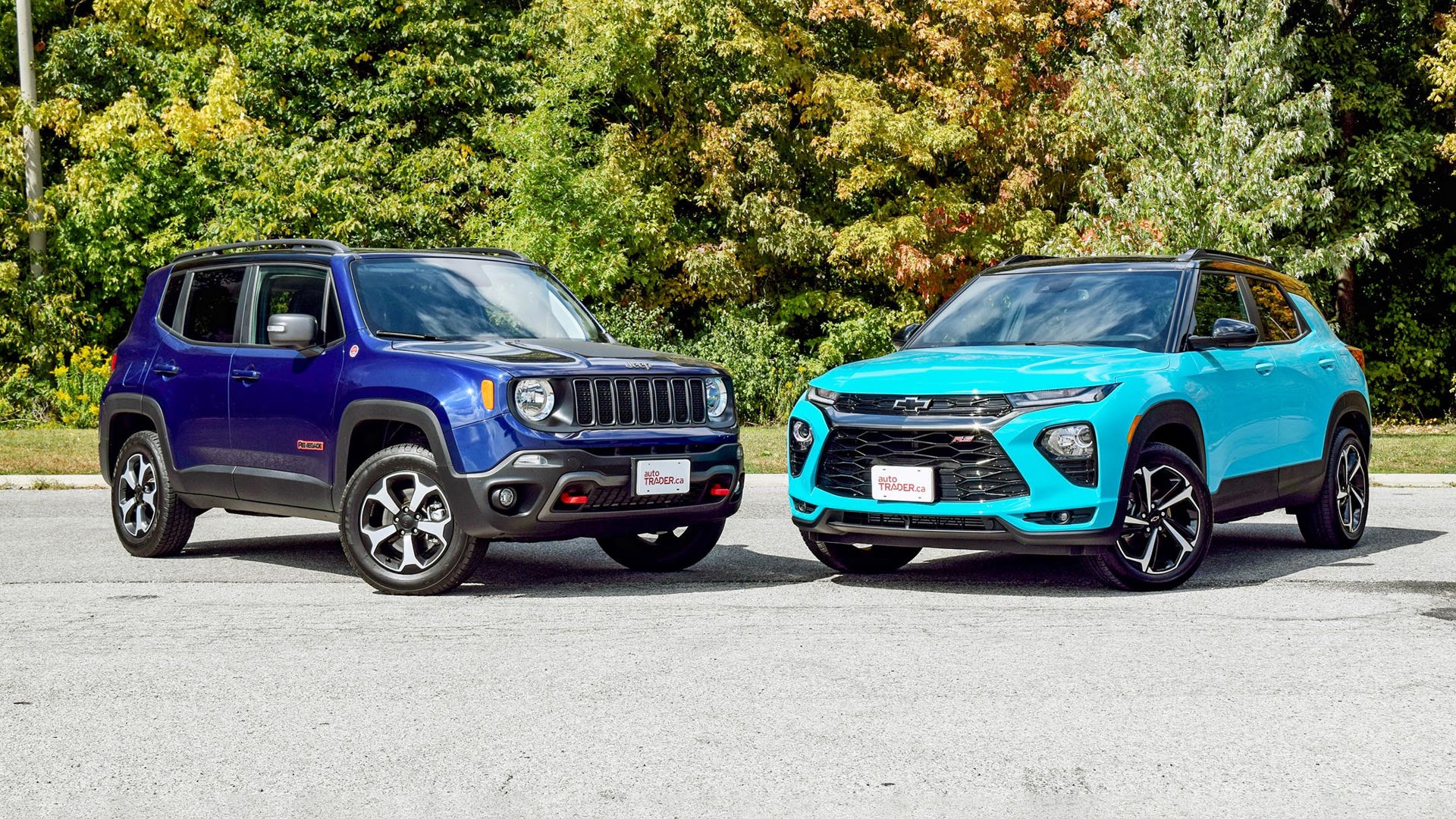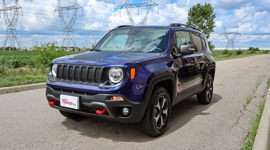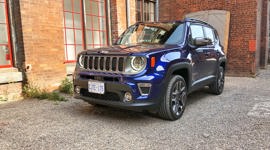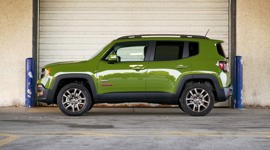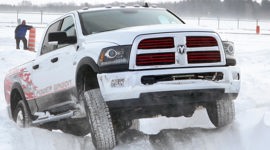 AutoTrader SCORE
AutoTrader SCORE
-
STYLING8/10
-
Safety8/10
-
PRACTICALITY7/10
-
USER-FRIENDLINESS8/10
-
FEATURES9/10
-
POWER7/10
-
COMFORT8/10
-
DRIVING FEEL8/10
-
FUEL ECONOMY8/10
-
VALUE7/10
The 2017 Jeep Renegade Trailhawk is a machine built to tackle terrain that’d leave a comparable Mazda CX-3, Honda HR-V, or Chevrolet Traxx with a bashed-in oil pan, and an owner scouring eBay for replacement bumpers. It may look cute and playful, but it’s built to occupy nothing less than a top-of-class position when it comes to small-SUV capability.
Capability and Trail Rated off-road prowess to spare
There’s capability and Trail Rated off-road prowess to spare here and that’s something to keep in mind when considering the price. This tester here carried some $5,500 in options, building on a $33,000-plus starting price for an as-tested sticker approaching $39,000. That’s big bucks for a little ute, even if it’s got the big stereo, remote start, navigation, several option packages, and the full-capability Trailhawk package bolted on.
The Trailhawk-grade Renegade will generate the highest return on investment for owners planning to use it vigorously in an off-road setting. If that’s not you, consider a lower-grade model, and save some cash.
Or don’t.
In my northern locale, Trailhawk-equipped Jeep models are the norm – and I’ve met dozens of owners who admit that the looks and cool-factor of the Trailhawk moniker held plenty of sway in the purchase decision, often more so than the capability. Case in point? A close friend with a Cherokee Trailhawk refuses to take it off-roading, because it’s too new, and he doesn’t want to get it dirty. He bought the Trailhawk package for its looks, not its capability, and paid handsomely for it. That’s some serious marketing horsepower.
When it comes to actual off-road capability, the Renegade Trailhawk shines in a few areas. The equipment list is impressive; with low-range gearing and a 20 to 1 crawl ratio, increased ride height, skid plates, tow hooks, improved articulation, high-clearance bumpers and tow-hooks, it’s built to tackle more than most will throw its way.
Drivers get an electronic off-road toolkit, accessible via a selector dial encircling a few buttons for easy selection of several off-road drive-modes, as well as low range, 4x4 lock, and downhill assist control, all engaged with a tap or twist. Novice off-roaders will find this a godsend: dial in the proper mode, click to activate any supplemental assistance, and the electronics set off optimizing traction to keep you moving.
You wince as you drive over obstacles that never touch the floor, climb over things you think it won’t, and pull out of the sort of slippery ruts that try to steal your footwear if you walk through them. Use the proper drive mode, and there’s always a just-right amount of wheelspin and throttle response to maintain momentum and grip.
The small size and short wheelbase makes the Renegade difficult to high-centre when climbing an obstacle, compared to something with a longer wheelbase. And you sit up high, which makes it easy to see where you are, and maneuver and place the Renegade wherever you’d like. Ditto the steering, which at low speeds is one-finger, feather-light. In most situations off-road, the Renegade Trailhawk feels like a highly capable and easily maneuvered little mountain goat of a machine.
Off-road ride quality is generally pretty good too. Renegade lacks the feel of full-on, ladder-frame toughness you’ll find in a Jeep Wrangler, but it takes a rough surface indeed to make it feel like it’s taking a beating. On rougher paved roads, I found the suspension to feel quieter and more robust than the Cherokee Trailhawk. On severe off-road surfaces, particularly with washboards or larger rocks, the suspension can become noisy and harsh though.
Functionally, Renegade offers headroom galore, thanks to its tall and boxy shape. Entry and exit for the average-sized occupant requires only a lateral butt-slide over and into a seat, and the cargo hold, though far from massive, flaunts a square-to-the-edges design that facilitates easy packing of stackable, square containers. Jump-in height for the family canine is on the tall side, and the rubber seals are on the body, not the tailgate itself, where they may be susceptible to sharp claws.
At-hand storage near the driver is generous, with numerous cubbies and compartments and a proper set of cupholders helping to keep you organized.
Elsewhere, this is one of the most unique cabins in the segment. Build quality is good, as is materials selection, while a smattering of chunky accents and modern controls dials up the richness. Ditto the effective use of colour and texture throughout. Further, designers sprinkled the whole thing with a multitude of loveable little details, like the image of a little Jeep climbing the windscreen, or the tiny Sasquatch dude on the rear window, or the use of a splatter of mud to designate the redline on the tachometer.
Call it gimmicky, but the abundant little details coaxed many a smile from passengers – including one family friend and art teacher, who fell in love with the Renegade, and considers it a prime candidate to replace her aging Toyota Yaris, and to take a place beside the Jeep Cherokee (North Edition) in her family driveway.
The tester’s Tigershark engine is a 2.4-litre four-cylinder with 180 horsepower. A mixed bag, here. On one hand, the engine is smooth and admirably quiet, even when pushed. On the other, when hammered upon for highway-speed passing or merging, the engine performs adequately, little more. It stays smooth and quiet, but many drivers will wish for added punch. To compare though, the Wrangler’s throttle and transmission tuning are lazy, with big V6 power, it fires along in a hurry when called upon. The Renegade doesn’t.
The nine-speed automatic never exhibited any clumsiness or tendency to hunt for the right gear, and it typically shifts so smoothly, you don’t notice up to eight upshifts deployed as you accelerate up to highway speeds.
At those highway speeds, the Renegade’s noise levels are kept nicely in check, provided you keep your speed reasonable. The ride feels relatively planted, stable and car-like when operated gently. It’s a compliant highway cruiser, and if you like the capability of a Wrangler, but want something more car-like and less clumsy to drive at higher speeds, the Renegade might be the ticket. Notably, where the Wrangler tends to drift slightly within its lane on account of a fairly vague steering feel, the Renegade feels a measure more locked on and planted and direct – even if the steering and brakes both feel somewhat syrupy at higher speeds, more like they’re made of warm Velveeta than steel.
Headlight performance is adequate, boasting good spread and peripheral reach. Curiously though, high-beam activation seems to add very little additional light up the road.
So, is the Renegade Trailhwak the Jeep to buy, when numerous Wrangler models, including the highly capable Willys Wheeler, are available for similar money? The answer is, “It depends.”
Shoppers after something off-road-ready but easier to drive, easier on fuel, easier to live with, and with a more expressive interior and more stable handling may find the Renegade a better pick. If not, when it comes to toughness, capability and feeling backed up by ruggedness galore, you won’t go wrong with the Wrangler either.
Best advice? With your budget in a new off-roader established, be sure to drive comparably priced versions of the Wrangler and Renegade to help decide which one is best for you and yours. The Renegade will be cheaper to run, easier to use for more novice off-roaders, and feels like less of a departure from driving a small car. The Wrangler boasts numerous compromises to handling, interior packaging, fuel efficiency and noise levels, though thousands of owners accept these as they mostly contribute to an even higher level of toughness and capability.
It’s always nice to have choices – and these are two good ones, depending what you’re after.
| Engine Displacement | 2.4L |
|---|---|
| Engine Cylinders | 4 |
| Peak Horsepower | 180 hp @ 6,400 rpm |
| Peak Torque | 175 lb-ft @ 3,900 rpm |
| Fuel Economy | 11.2/8.2/9.8 L/100 km city/hwy/cmb |
| Cargo Space | 523.9 L/1438.5 L seats down |
| Model Tested | 2017 Jeep Renegade Trailhawk |
| Base Price | $33,045 |
| A/C Tax | $100 |
| Destination Fee | $1,795 |
| Price as Tested | $40,470 |
|
Optional Equipment
$5,530 – Cold Weather Group $895; Trailer Tow Group $350; Safety and Security Group $890; Premium Navigation Group $1,100; Popular Equipment Group $850; Beats Stereo $995; Back-up Camera $450
|
|
